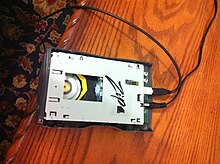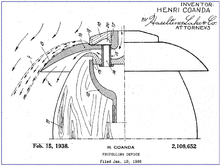Bernoulli Effect/Howard Community College/Fall2011/502 Desiz
Electronic Sections Expected
[edit | edit source]Problem Statement
[edit | edit source]To differentiate between Bernoulli and Coanda Effect.
Team Members
[edit | edit source]Put each team members name here with links to their personal page here. Real names do not have to be used.
- User:Mkhan4793/enes100/Bernoulli Effect
- User:Hsingh8658/enes100/Bernoulli Effect
- User:Afayyaz6843/enes100/Bernoulli Effect
Summary
[edit | edit source]The main purpose of our project was to distinguish between Coanda and Bernoulli effect. We started by looking at some demonstrations of bernoulli effect. While looking through them, we found that some applications of Bernoulli effect were explained erroneously. We were focussing more on floating of table tennis ball in air stream of hair dryer. Bernoulli's law cannot be applied to a free air stream because friction plays an important role. The situation is similar to the laminar flow of a liquid with viscosity inside a tube. The different velocity of the stream layers is caused by viscosity. The static pressure is same throughout the whole cross-section. A free air stream in the atmosphere is decelerated by friction. If static pressure in a free air stream is equal to atmospheric pressure, some of the demonstrations are interpreted incorrectly since the effects observed are not caused by Bernoulli's law. The ball remains in air due to Coanda effect. Due to coanda effect the air stream sticks to the surface of the ball and the airstream is directed downward and the reaction force keeps the ball upwards. The following link explains this effect http://www.sciencetoymaker.org/balloon/links.html One source of confusion is the derivation of Bernoulli's law based on the theorem of energy conservation. Bernoulli's law should be derived from the tangential acceleration as a consequence of declining pressure. Another source of difficulties is the fact that many physics textbooks do not mention normal acceleration of flow and the resulting pressure gradients perpendicular to the flow.
Both, Bernoulli's law and the generation of pressure gradients perpendicular to the flow are consequences of Newton’s laws. None of them contradicts those.
Bernoulli's law is insufficient to explain the generation of low pressure. A faster streaming velocity never produces or causes lower pressure. The physical cause of low or high pressure is the forced normal acceleration of streaming air caused by obstacles or curved planes in combination with the Coanda-effect. Pressure gradients generated by the deflection of streaming air can be clearly demonstrated by simple experiments.Coanda is the tendency of a moving fluid, either liquid or gas, to attach itself to a surface and flow along it. As a fluid moves across a surface a certain amount of friction (called "skin friction") occurs between the fluid and the surface, which tends to slow the moving fluid. This resistance to the flow of the fluid pulls the fluid towards the surface, causing it stick to the surface. Thus, a fluid emerging from a nozzle tends to follow a nearby curved surface-even to the point of bending around corners-if the curvature of the surface or the angle the surface makes with the stream is not too sharp.
Poster
[edit | edit source]Added poster

We have put the pictures of the demonstrations that we had done in the order:














Story
[edit | edit source]Our explanation of Bernoulli effect for standing of ping-pong ball in air was also wrong.The correct explanation involves the Coanda effect. When the air stream flows past the ball, some of the air follows the contour of the ball and only leaves after it moves a significant distance along the surface of the ball. In effect, the ball is "pulling" the air around its surface. There must always be some reaction force on the ball, which points in the direction of the air stream and upward, holding the ball in the air. This effect can be better understood by following this http://www.sciencetoymaker.org/balloon/links.html
We also had worked on different demonstrations during the coarse of last few weeks.
http://www.youtube.com/watch?v=Q7psavgw98Q
http://www.youtube.com/watch?v=bNNfs2P5Gkc&feature=related
http://www.youtube.com/watch?v=Z95TKv1YEPA&feature=related
http://www.youtube.com/watch?v=nsqNO_yPKg0&feature=related
These demonstrations were done by different team members put effort in them individually.
Decision List
[edit | edit source]We decided to work on the mechanism of Bernoulli Box. We did understood how it was working,but we were not able to find the bernoulli disk. Because of the reason we didn't get the bernoulli disk, we were not able to show the demonstration. We all decided to demonstrate the Bernoulli effect, but all agreed that the effect we demonstrated was more of a Coanda and not Bernoulli.
Material List
[edit | edit source]Two Hair driers.
Ping Pong balls
Zip drive that was designed on the basis of the Bernoulli principal.
Tube
5.0 amp adapter, and USB cable for zip drive
plain paper
roll of toilet paper
blower
Software List
[edit | edit source]The most part was to research using different search engines. Used different websites to conclude the information and research.
No particular software was used and needed for this project.
Time
[edit | edit source]The amount of time we spent on pushing the project forward was 5-6 hours weekly and 2 class periods. That's makes a total of 24 hours for each and a team total of 72 hours. Additional time was spent if needed to finish something. We all gathered up in the library, shared our ideas, and finished anything that was incomplete.
Tutorials
[edit | edit source]Doing research and understanding the difference between Bernoulli effect and coanda was the most important part of the project. Links on user-pages of our team members can be very helpful in understanding those differences.
Most of the tutorials we got were from youtube videos.
Next Steps
[edit | edit source]The research has been done from a variety of different resources. The differentiation has also been done on Coanda and Bernoulli effect based on the research we had done. The next step would be to design something new to distinguish between Coanda and Bernoulli Effect. Find a Bernoulli disk and make the motor spin to show the Bernoulli Effect in the Iomega Zip Drive.
Demonstrate the bernoulli effect using balloons
Misconceptions About Bernoulli Effect
[edit | edit source]We have reseached and done a lot of demonstrations in order to differentiate Bernoulli Effect with Coanda Effect. Our research mostly started with the explanations about Coanda effect which we thought was the Bernoulli Effect. The demonstrations that we did with the ping pong balls was the coanda effect. After having a discussion with the team mates, we came to the conclusion that the Bernoulli effect is the phenomenon of internal pressure reduction with increased stream velocity in a fluid.
These pictures are given in order to show the correctness of the airplane flight.
